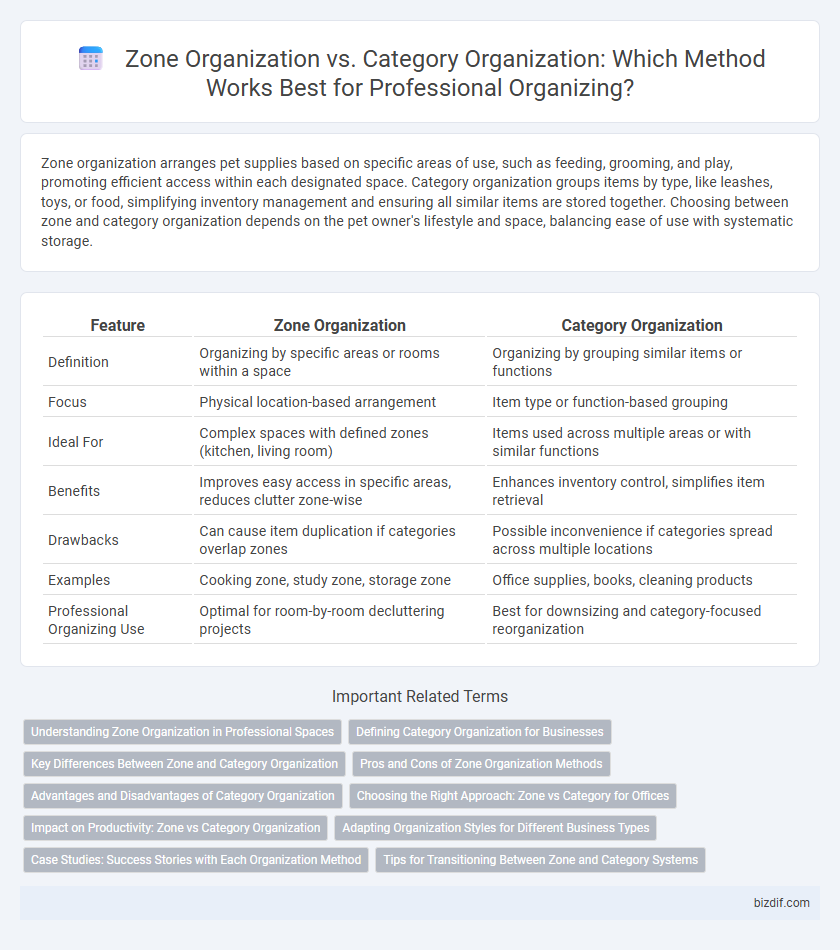Zone organization arranges pet supplies based on specific areas of use, such as feeding, grooming, and play, promoting efficient access within each designated space. Category organization groups items by type, like leashes, toys, or food, simplifying inventory management and ensuring all similar items are stored together. Choosing between zone and category organization depends on the pet owner's lifestyle and space, balancing ease of use with systematic storage.
Table of Comparison
| Feature | Zone Organization | Category Organization |
|---|---|---|
| Definition | Organizing by specific areas or rooms within a space | Organizing by grouping similar items or functions |
| Focus | Physical location-based arrangement | Item type or function-based grouping |
| Ideal For | Complex spaces with defined zones (kitchen, living room) | Items used across multiple areas or with similar functions |
| Benefits | Improves easy access in specific areas, reduces clutter zone-wise | Enhances inventory control, simplifies item retrieval |
| Drawbacks | Can cause item duplication if categories overlap zones | Possible inconvenience if categories spread across multiple locations |
| Examples | Cooking zone, study zone, storage zone | Office supplies, books, cleaning products |
| Professional Organizing Use | Optimal for room-by-room decluttering projects | Best for downsizing and category-focused reorganization |
Understanding Zone Organization in Professional Spaces
Zone organization in professional spaces divides areas based on specific activities or functions, enhancing workflow efficiency and reducing time spent searching for tools or documents. Unlike category organization that groups similar items together regardless of location, zone organizing places related items within their respective functional zones for immediate accessibility. Implementing zones tailored to tasks such as collaboration, administration, or creative work fosters a streamlined environment optimized for productivity and task completion.
Defining Category Organization for Businesses
Category organization for businesses involves grouping items based on their function or type, enabling easier access and streamlined inventory management. This method supports efficient workflow by ensuring similar products or materials are stored together, reducing search time and improving productivity. Employing category organization enhances clarity in supply chain processes and aids in quicker restocking decisions.
Key Differences Between Zone and Category Organization
Zone organization arranges items based on specific areas or functions within a space, optimizing accessibility for tasks performed in that zone. Category organization groups similar items together regardless of location, enhancing inventory management and reducing duplication. Understanding these key differences helps tailor professional organizing strategies to user habits and spatial requirements.
Pros and Cons of Zone Organization Methods
Zone organization methods streamline space by grouping items based on their functional areas, enhancing task efficiency and reducing time spent searching for tools or supplies. This approach fosters a logical layout tailored to activity flow, but it may limit flexibility when items naturally belong to multiple zones or when zones become cluttered. While zone organization encourages focused use of specific areas, it can lead to challenges in maintaining overall order if boundaries between zones are not clearly defined and regularly adjusted.
Advantages and Disadvantages of Category Organization
Category organization enhances efficiency by grouping similar items, making it easier to locate and maintain belongings, which reduces clutter and time spent searching. However, it can lead to disorganization in multi-use spaces where items from different categories are frequently used together, causing inconvenience. This method may also require more storage solutions and labeling to keep categories clearly defined, which can increase the complexity of the system.
Choosing the Right Approach: Zone vs Category for Offices
Zone organization in offices clusters items based on their function within specific work areas, enhancing workflow efficiency by minimizing movement between zones. Category organization groups similar items together regardless of location, ideal for storing supplies like stationery or documents, and simplifies inventory management. Selecting between zone and category organization depends on office size, employee roles, and task nature to optimize accessibility and productivity.
Impact on Productivity: Zone vs Category Organization
Zone organization enhances productivity by grouping items based on their physical location, reducing time spent moving between areas and streamlining access during specific tasks. Category organization improves efficiency by clustering similar items together regardless of location, facilitating faster retrieval through logical sorting and minimizing cognitive load. Choosing between zone and category organization depends on task workflow and space layout, with both methods significantly boosting productivity when aligned with user habits.
Adapting Organization Styles for Different Business Types
Zone organization groups items based on their physical location within a workspace, enhancing workflow efficiency for businesses with spatial constraints like retail stores or warehouses. Category organization sorts items by type or function, making it ideal for offices or creative studios that require quick access to specific materials and resources. Adapting organizational styles according to the unique operational needs and layout of different business types maximizes productivity and reduces clutter effectively.
Case Studies: Success Stories with Each Organization Method
Case studies reveal that zone organization excels in environments where proximity and function boost efficiency, such as in kitchens or home offices, by grouping items based on usage areas. Category organization demonstrates success in closets and garages by sorting belongings into specific groups like clothing or tools, simplifying retrieval and inventory management. Both methods increase productivity and reduce clutter, with zone organization enhancing workflow and category organization improving systematic order.
Tips for Transitioning Between Zone and Category Systems
Transitioning between zone and category organization requires a clear plan that defines the primary purpose of each space and item group. Begin by assessing your current system's strengths and identifying which zones or categories best support daily routines and accessibility. Utilize labels and storage solutions that can be adapted easily, ensuring that items maintain logical groupings whether by function or type throughout the transition.
zone organization vs category organization Infographic

 bizdif.com
bizdif.com